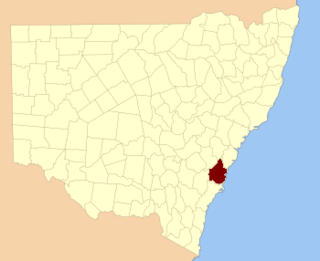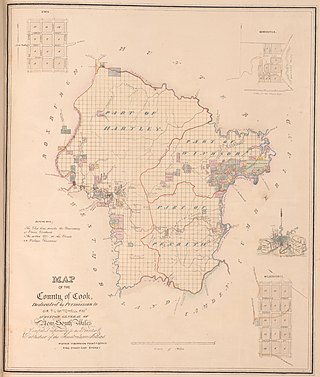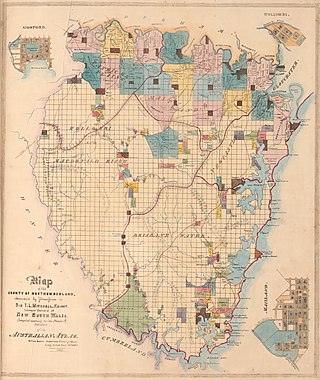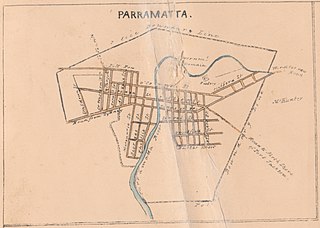Related Research Articles
Western Boroughs was an electoral district for the Legislative Assembly in the Australian state of New South Wales from 1856 to 1859. It included the towns of Bathurst, Carcoar and Kelso, while the surrounding rural areas were in Bathurst (County) and Cook and Westmoreland. It was replaced by Bathurst and Carcoar.

The Electoral district of County of Bathurst was an electorate of the New South Wales Legislative Council at a time when some of its members were elected and the balance were appointed by the Governor.

The Electoral district of County of Camden was an electorate of the New South Wales Legislative Council at a time when some of its members were elected and the balance were appointed by the Governor.

The Electoral district of Pastoral Districts of Clarence and Darling Downs was an electorate of the New South Wales Legislative Council at a time when some of its members were elected and the balance were appointed by the Governor. It was a new electorate created in 1851 by the expansion of the Legislative Council to 54, 18 to be appointed and 36 elected. It included the Clarence Valley and the Darling Downs region, which became part of Queensland on its establishment in 1859.
The Electoral district of Sydney Hamlets was an electorate of the New South Wales Legislative Council at a time when some of its members were elected and the balance were appointed by the Governor. It was a new electorate created in 1851 by the expansion of the Legislative Council to 54 members, with 18 to be appointed and 36 elected. The electoral district included what were then outer suburbs of Sydney and are now the inner suburbs of Glebe, Camperdown, O'Connell Town, Chippendale, Redfern, Surry Hills, Paddington, St Leonards and Balmain.
The Electoral district of Stanley Boroughs was an electorate of the New South Wales Legislative Council at a time when some of its members were elected and the balance were appointed by the Governor. It was a new electorate created in 1851 by the expansion of the Legislative Council to 54 members, with 18 to be appointed and 36 elected. The previous district of Counties of Gloucester, Macquarie, and Stanley was split into the districts of Gloucester & Macquarie, Stanley and Stanley Boroughs. The district included North Brisbane, South Brisbane, Kangaroo Point and Ipswich.
The 1856 New South Wales colonial election was to return 54 members of Legislative Assembly composed of 34 electoral districts with 18 returning 1 member, 13 returning 2 members, two returning 3 members and one returning 4 members, all with a first past the post system. In multi-member districts, because each voter could cast more than one vote, it is not possible to total the votes to show the number of voters and voter turnout in these districts is estimated. 8 members from 6 districts were returned unopposed.

The Electoral district of Counties of Cook and Westmoreland, also known as the United Midland Counties of Cook and Westmoreland, was an electorate of the New South Wales Legislative Council at a time when some of its members were elected and the balance were appointed by the Governor.
The electoral district of Cumberland Boroughs, also known as the united towns of Windsor, Richmond, Liverpool and Campbelltown, was an electorate of the New South Wales Legislative Council at a time when two thirds were elected, one sixth were official members, that is they held a government office and the balance were appointed by the Governor.
The Electoral district of Counties of Murray, King and Georgiana and from 1851, Counties of King and Georgiana was an electorate of the partially elected New South Wales Legislative Council, created for the first elections for the Council in 1843. The electoral district included the south western counties of Murray, King and Georgiana. Polling took place at Queanbeyan, Yass and Wheeo, which were within the counties and the nearby towns of Braidwood, Goulburn and Bathurst. The towns of Queanbeyan and Yass were removed from the district with the expansion of the Council in 1851 and combined with Braidwood and Goulburn to form the Southern Boroughs. The rural area of the County of Murray became part of the Counties of Murray and St Vincent and leaving the district to cover the remaining rural areas of the Counties of King and Gergiana.
The Electoral district of Counties of Roxburgh, Phillip and Wellington and from 1851, Roxburgh and Wellington, was an electorate of the partially elected New South Wales Legislative Council, created for the first elections for the Council in 1843. The electoral district included the western counties of Roxburgh, Phillip, Wellington County. Polling took place at Montefiores, Mudgee, Bathurst and Hartley. The County of Phillip was removed from the district with the expansion of the Council in 1851 and became part of the Counties of Phillip, Brisbane and Bligh.

The Electoral district of Northumberland Boroughs was an electorate of the partially elected New South Wales Legislative Council, created for the first elections for the Council in 1843. From 1843 until 1851 the electorate covered the major towns or boroughs of Northumberland County, East Maitland, West Maitland and Newcastle, and polling took place at East Maitland, West Maitland and Newcastle. Morpeth was added to the electorate from 1851 while Newcastle was removed from the electorate to form, with Raymond Terrace, the North Eastern Boroughs. The rest of Northumberland County was covered by the County of Northumberland from 1843 until 1951, and Counties of Northumberland and Hunter from 1851 until 1856.

The Electoral district of Town of Parramatta was an electorate of the partially elected New South Wales Legislative Council, created for the first elections for the Council in 1843, at the time the principal residence of the Governor Sir Charles FitzRoy. Polling took place at Parramatta. In 1856, the unicameral Legislative Council was abolished and replaced with an elected Legislative Assembly and an appointed Legislative Council. The district was represented by the Legislative Assembly Parramatta, the only electorate to have existed continuously since the first Legislative Assembly election in 1856.
The Electoral district of Pastoral Districts of Lachlan and Lower Darling was an electorate of the New South Wales Legislative Council at a time when some of its members were elected and the balance were appointed by the Governor. It was a new electorate created in 1851 by the expansion of the Legislative Council to 54, 18 to be appointed and 36 elected. The district covered the south west of New South Wales was named after the Lachlan and Darling Rivers. On its eastern side were the districts of County of Bathurst and Counties of King and Georgiana, to the north was the Pastoral Districts of Wellington and Bligh and to the south was the Counties of Murray and St Vincent. Polling was to occur in the towns of Binalong, Wagga Wagga, Balranald, Canowindra, Gundagai and Yass.
The Electoral district of Pastoral District of Maneroo was an electorate of the New South Wales Legislative Council at a time when some of its members were elected and the balance were appointed by the Governor. It was a new electorate created in 1851 by the expansion of the Legislative Council to 54, 18 to be appointed and 36 elected. The district covered the Maneroo region now known as Monaro in the south east of New South Wales. To its north was the Electoral district of Counties of Murray and St Vincent. Polling was to occur in the towns of Goulburn, Eden, Cooma and Bombala.
The Electoral district of North Eastern Boroughs was an electorate of the New South Wales Legislative Council at a time when some of its members were elected and the balance were appointed by the Governor. It was a new electorate created in 1851 by the expansion of the Legislative Council to 54, 18 to be appointed and 36 elected. The district consisted of the towns of Newcastle, Stockton and Raymond Terrace that had previously been part of Northumberland Boroughs.
The Electoral district of Southern Boroughs was an electorate of the New South Wales Legislative Council at a time when some of its members were elected and the balance were appointed by the Governor. It was a new electorate created in 1851 by the expansion of the Legislative Council to 54, 18 to be appointed and 36 elected. The district consisted of the towns of Goulburn, Braidwood, Yass and Queanbeyan, while the surrounding rural area were in the districts of Argyle, Counties of Murray and St Vincent and Counties of King and Georgiana.
The Electoral district of Counties of Murray and St Vincent was an electorate of the New South Wales Legislative Council at a time when some of its members were elected and the balance were appointed by the Governor. It was a new electorate created in 1851 by the expansion of the Legislative Council to 54, 18 to be appointed and 36 elected. The district consisted of the rural areas of Murray County, which had previously been part of Counties of Murray, King and Georgiana, and St Vincent County, which had previously been part of Counties of St Vincent and Auckland. The towns of Braidwood and Queanbeyan were not part of the district, being included in Southern Boroughs.
The Electoral district of Pastoral Districts of Moreton, Wide Bay, Burnett, and Maranoa was an electorate of the New South Wales Legislative Council at a time when some of its members were elected and the balance were appointed by the Governor. It was a new electorate created in 1851 by the expansion of the Legislative Council to 54, 18 to be appointed and 36 elected. The district was named after the early settlements of Moreton Bay; Wide Bay, near Maryborough; the Burnett River, near Bundaberg; the Maranoa region of South-western Queensland. These became part of Queensland on its establishment in 1859.

The Electoral district of County of Stanley was an electorate of the New South Wales Legislative Council at a time when some of its members were elected and the balance were appointed by the Governor. It was a new electorate created in 1851 by the expansion of the Legislative Council to 54 members, with 18 to be appointed and 36 elected. The previous district of Counties of Gloucester, Macquarie, and Stanley was split into the districts of Gloucester & Macquarie, Stanley and Stanley Boroughs, which included North Brisbane, South Brisbane, Kangaroo Point and Ipswich.
References
- 1 2 "An Act to provide for the division of the Colony of New South Wales after the separation of the District of Port Phillip therefrom into Electoral Districts and for the Election of Members to serve in the Legislative Council.". Act No. 48 of 2 May 1851 (PDF). Australasian Legal Information Institute. Retrieved 10 September 2014.
- ↑ "Mr Arthur Holroyd (1806–1887)". Former members of the Parliament of New South Wales . Retrieved 1 May 2019.
- ↑ "The Western Boroughs". The Sydney Morning Herald . 23 September 1851. p. 3. Retrieved 29 May 2019– via Trove.